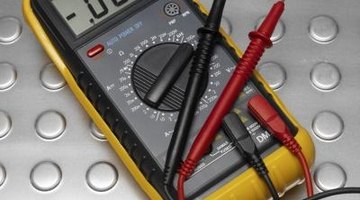How to Test 240-Volt Receptacles
Testing 240-volt receptacles is something every do-it-yourself person will have to do from time to time. You use these receptacles to supply power to electric ranges and clothes dryers. The two most common types of 240-volt receptacles that you will encounter are the National Electrical Manufacturer's Association (NEMA) 14-30 and the 14-50 configuration. You use the NEMA 14-30 with clothes dryers and the NEMA 14-50 with electric ranges. The 14-30 has an L-shaped slot at the top and a half-round opening at the bottom, with a vertical slot on each side. The 14-50 has a vertical slot at the top, a half-round opening at the bottom ,and one vertical slot on each side.

-
Unplug the electric range or clothes dryer from the receptacle to be tested. In order to gain access to the receptacle, you will have to move the appliance away from the wall. In the case of a clothes dryer, be careful not to damage the vent tube.
-
Plug the test leads that came with you digital multimeter into the meter. Turn the meter on, and set the function switch to the "AC Volt" function. If you have an auto-ranging meter, the meter will select the appropriate voltage range. If you have a manual meter, set the "Function/Range" switch to the "500 Volts AC" position.
-
Place one of the test probes in each of the vertical slots on the left and right sides of the receptacle. The meter should display a reading between 220 and 240 volts on the Liquid Crystal Display (LCD), if both hot wires have voltage on them. If the meter displays 0.000 volts, go to the next step.
-
Take a reading between each of the phase-wire slots, the vertical slots on the left and right, and the system ground, the half-round slot. Normally there will be 110 to 120 between a phase wire and ground. If you get this reading between one phase-wire slot and the ground but not between the other phase-wire slot and ground, the problem is an open phase. If the meter indicates an open phase proceed to the next step.
-
Check the circuit breaker or fuses. Many homes still use fuses instead of circuit breakers and one fuse can blow while the other one remains viable. If one fuse opens while the other one remains viable, you will get an open phase reading. It's possible that you have a defective wire or receptacle but not likely. If you have a double-pole circuit breaker, reset the breaker by switching it off and then back on. It's possible that one pole tripped open while the other remained closed.
-
Take a reading between each of the phase wire slots and the neutral wire slot at the top of the receptacle. The meter should display 110 to 120 volts between each of the phases and the neutral. If you have 220 to 240 volts between phases but 0.000 volts between the phases and the neutral, you have a neutral wire.
Writer Bio
Based in Colorado Springs, Colo., Jerry Walch has been writing articles for the DIY market since 1974. His work has appeared in “Family Handyman” magazine, “Popular Science,” "Popular Mechanics," “Handy” and other publications. Walch spent 40 years working in the electrical trades and holds an Associate of Applied Science in applied electrical engineering technology from Alvin Junior College.
Photo Credits
- Polka Dot Images/Polka Dot/Getty Images
More Articles



